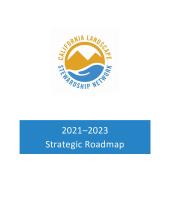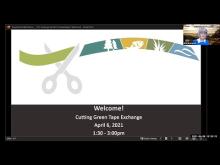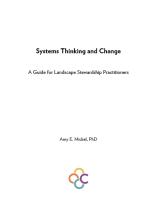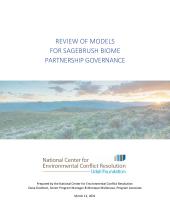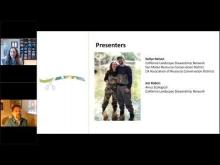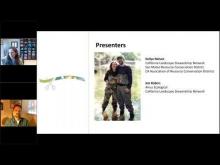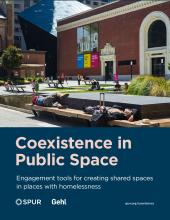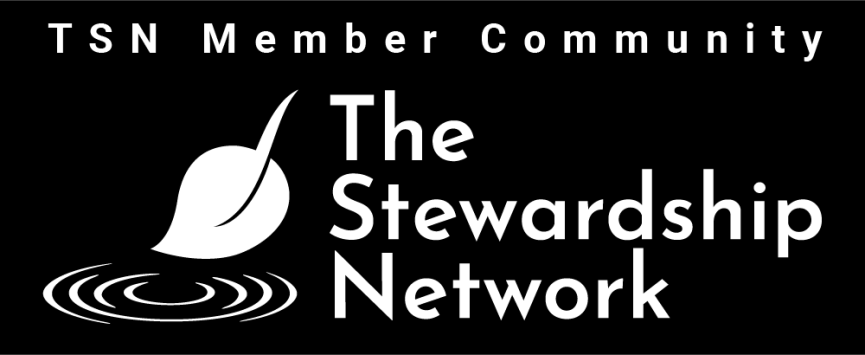- Details
-
During the fall of 2020, the California Landscape Stewardship Network (CA Network) Steering Committee undertook a process to review Network successes, to assess current needs and opportunities, and to chart a course forward. The Steering Committee relied on several sources for candid feedback and new ideas, including:
- targeted interviews with Steering Committee members and key CA Network partners/advisers,
- a Network-wide participants survey, and
- in-depth discussions among the Steering Committee on key issues.
What we heard was agreement that there are specific areas where the CA Network has been successful as well as opportunities for evolution or growth. One of the key findings was that the CA Network does not act like a formal organization, but rather serves as a platform for people to work together in new ways. Because it works on emergent needs and opportunities, and remains highly adaptive and constantly in process, it needs a “strategic roadmap” rather than a traditional strategic plan. This document provides that roadmap though guidance on how to maintain Network strengths and ways to sustain its ongoing and successful journey. We consider this strategic roadmap to be a living document, and welcome questions, feedback, and further insights from our community of practice and collaborators.
- Details
-
On April 6, 2021, the California Landscape Stewardship Network hosted a virtual event on Cutting Green Tape that brought together colleagues from California Natural Resources Agency and restoration practitioners from across the state to share updates and engage around future efforts for the initiative.
Speakers and panelists included:
- Wade Crowfoot, California's Secretary for Natural Resources
- Jen Norris, Deputy Secretary for Habitat and Biodiversity
- Chad Dibble, Deputy Director of Ecosystem Conservation Division, CDFW
- Paul Hann, Chief of Watersheds and Wetlands, State Water Resources Control Board
- Erika Lovejoy, Program Director for Accelerating Restoration at Sustainable Conservation
- Kellyx Nelson, Executive Director of San Mateo RCD and CLSN Steering Committee
The conversation was moderated by Shawn Johnson.
- Details
-
As we continue to face complex and difficult-to-solve problems such as climate change, social injustice, and a global pandemic, the need for collaboration is more pressing than ever. Multi-stakeholder partnerships (MSPs) are touted as promising mechanisms to tackle these challenges; however, despite their promise, not all partnerships are successful in their collaborative efforts. The presence or absence of individuals with the right mindset to participate in a collaborative leadership process is one common explanation for this.
The purpose of the research presented here is to better understand collaboration in the context of MSPs. Answering the question “Which behaviors foster collaboration and which ones discourage collaboration?” can help us address the question of “How do you effectively participate in the process of collaborative leadership?” In this research, qualitative data were collected and analyzed to reveal behaviors that influence successful collaboration.
- Details
-
In an effort to create a shared language and understanding for landscape stewardship practitioners, terms related to systems, such as systems thinking and systems change, are defined in this guide. Systems in three classifications—biosphere, social, and technosphere—are highlighted. These three systems all share the characteristics of interconnectedness, interdependency, and dynamism
Systems thinking is a lens through which we can understand, diagnose, and solve complex issues, in addition to a lens for decision-making and future planning. Both a process and an outcome, systems change is the action-oriented side of systems thinking, intended to produce long-lasting change.
This guide concludes with a checklist that can be used when approaching problems through a systems-thinking and systems-change perspective. When applying this perspective, the practice of collaborative leadership is highlighted as the most effective approach to tackling today’s complex problems.
- Details
-
The Udall Foundation's Center for Environmental Conflict Resolution reviewed three key collaborative partnership models (the North American Wetlands Management Plan and associated Joint Ventures, the Northwest Boreal Partnership, and the Chesapeake Bay Program) and four secondary models (Blackfoot Challenge, Crown of the Continent, the National Invasive Species Council, and the Southeast Conservation Adaptation Strategy) to identify lessons learned and best practices that could be applied to the development of a collaborative partnership in the sagebrush biome.
- Details
-
How can we increase the pace and scale of the ecological restoration and land stewardship necessary for climate resilient lands and water? One way is to change the permitting and regulation requirements so they encourage the “good” instead of just preventing the “bad.” That’s one of the goals of the Cutting Green Tape initiative which launched last year with a paper, Cutting Green Tape: Regulatory Efficiencies for a Resilient Environment. Watch this conversation with Sharon Farrell (Golden Gate National Parks Conservancy) and Kellyx Nelson (San Mateo Resource Conservation District) - both leaders of the California Landscape Stewardship Network - about what this means for you and our collective effort to build climate resilient lands and communities.
Learn more about TOGETHER Bay Area at www.TogetherBayArea.org
- Details
-
The California State Coastal Conservancy hosted a webinar on 2/3/21 with Kellyx Nelson and Jim Robins about the Cutting Green Tape initiative and why it is needed to protect our natural resources. Ms. Nelson and Mr. Robins are two of the lead authors of the Cutting Green Tape: Regulatory Efficiencies for a Resilient Environment report (November 2020) and discuss the need for changes in our regulatory processes and present the recommendations in the report. With Trish Chapman, Central Coast Regional Manager, State Coastal Conservancy.
- Details
-
In recent years the number of people experiencing homelessness has grown rapidly in many American cities, raising new questions about who public space is designed for. As more and more Bay Area residents find themselves without homes, many have defaulted to living in public spaces such as parks, plazas and squares. These spaces were not designed to be homes, however, and housed users voice concerns that the presence of unhoused residents degrades public spaces, rendering them unwelcoming or even unsafe.
At the same time, people who do not have access to stable housing are members of the community and should not be denied the use of public space simply because of their living situation. As long as our cities do not provide housing for all who need it, our neighborhoods will continue to face the challenge of how housed and unhoused users can coexist in public space.
This report introduces the toolkit, which can be downloaded at spur.org/coexistence, and offers considerations for community discussion.
- Details
-
Connecting landscape-scale conservation partnerships through a national network will be essential to achieving the Biden Administration’s ambitious goals around biodiversity (“30 x 30” initiative), equity, and climate change. While some attempts have been made to coordinate landscape conservation efforts across the country, a robust, cohesive, nationwide network is not in effect today. We provide recommendations for building back a better national framework that supports landscape conservation efforts across the United States.


